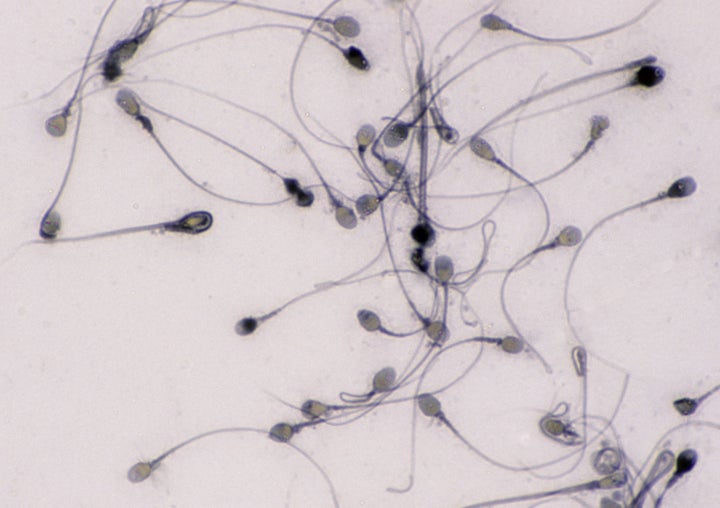“We need to look at it in a bigger perspective, rather than focusing on if you get a baby or don’t get a baby.”
About 12 percent of American women of childbearing age have trouble getting and staying pregnant, and about 7.5 percent of sexually experienced men under 44 have seen a fertility doctor, according to the U.S. Centers for Disease Control and Prevention. Yet despite the fact that infertility is so common, there’s a lot we don’t know about it.
Silence about the condition contributes to the sense of shame people feel about being unable to conceive, and infertility’s status among other medical conditions leaves researchers struggling to win funding that can help advance the field.
Stigma about infertility is so strong that it gets in the way of even basic scientific research about the human reproductive system, says Richard Stouffer, a fertility scientist at Oregon Health and Science University School of Medicine. Just as infertile couples are sometimes told they’re “not meant to be parents,” fertility specialists are told their medical research is not a priority.
“Some people would actually say infertility is not a significant problem relative to other diseases like cardiovascular disease or cancer, because it’s not life-threatening,” Stouffer told HuffPost. “But if you’re a young woman who has been trying to get pregnant for a year and is willing to pay tens of thousands of dollars to try to get pregnant through [fertility treatments], you obviously don’t agree with that.”
And it’s not just about the ability to get and stay pregnant. Thinking of infertility as a non-fatal medical condition ignores the fact that people who are infertile are also at higher risk of major diseases like cancer, cardiovascular disease and diabetes than the general population, says Dr. Marcelle Cedars, director of the division of reproductive endocrinology at the University of California, San Francisco.
“To look at [fertility] in isolation and decide whether it has value to society or for research is really pretty narrow, because reproduction is such a fundamental process of how all animals survive that it has to be key to our overall general health,” Cedars said. “We need to look at it in a bigger perspective, rather than focusing on if you get a baby or don’t get a baby.”
“We need to look at it in a bigger perspective, rather than focusing on if you get a baby or don’t get a baby.”
While scientists and clinicians have vastly improved fertility treatments since the first baby was born through in vitro fertilization in 1978, the truth is that there is still a lot we don’t know about what causes infertility, or how to help people conceive. HuffPost talked to four fertility scientists who each discussed what they wish they knew about infertility, and which pieces of knowledge could potentially help the most people.
1. We still don’t know what causes the most common infertility-associated condition for women in the U.S.

PCOS, or polycystic ovarian syndrome, is the most common cause of infertility in women. Women with PCOS produce abnormally high levels of androgens — hormones that are naturally high in men, such as testosterone — and this hormone imbalance has a wide variety of symptoms, including excess hair growth and acne. Most importantly for infertile couples, PCOS prevents ovulation, or the release of an egg from the ovary. This results in irregular or missed monthly periods and prevents couples from effectively timing sex for conception. Women with PCOS are more likely to lose pregnancies when they do manage to conceive.
The condition may affect as many as 10 percent of all women in the U.S. and increases their risk of endometrial cancer, Type 2 diabetes and heart attack.
If scientists could figure out why PCOS starts in the first place, it could empower women to take steps to prevent the syndrome from taking root. It’s thought to be at least partially genetic, as women are more likely to have PCOS if they have relatives that also have the condition. Some research has also found a link to high body fat and BMI. What research has not been able to determine is which comes first: Does being overweight and having large amounts of fat tissue lead to hormone imbalance, or does an initial hormone imbalance lead to weight gain?
What’s more, there is a phenomenon of “lean PCOS,” in which women of normal weight have elevated androgen levels and do not ovulate regularly.
To get to the bottom of these questions, Stouffer is conducting a years-long randomized controlled trial involving rhesus monkeys to see whether elevated androgen levels, obesity or a combination of both things sparks PCOS in the animals. He hopes over the five-year experiment to see which monkeys develop PCOS and stop ovulating regularly, and then see if he can cure them of the syndrome by scaling back on the hormones, making them lose weight or a combination of both.
“Let’s presume there is a genetic component for the onset of PCOS. We’re not going to be able to change those genes,” said Stouffer. “But at least if we know how those symptoms develop, and then we can prevent those symptoms, then that would be a novel treatment.”
2. We don’t even really understand how normal sperm production works.

There are many diagnoses for male infertility, including misshapen sperm, sperm that are unable to “swim,” and sperm with damaged DNA. Alternately, there simply may not be enough sperm to normally fertilize an egg. While some sperm volume problems relate to physical obstructions, other “sperm genesis” problems don’t have a clear cause. This is particularly challenging because researchers don’t understand the underlying molecular causes of this lack of production, according to Dolores Lamb, Director for the Center for Reproductive Medicine at Baylor College of Medicine.
“There’s a lot we don’t understand about the controls for the production of sperm by the testes,” said Lamb. “Since we don’t understand the normal process, it’s impossible to properly diagnose the cause of why this doesn’t work properly in infertile men.”
Lamb is most interested in learning why, in some men, there is a complete failure of any sperm production, resulting in zero sperm cells in the testes. Understanding why this happens could unlock not only the cause of male infertility in general, but could lead to clues about cell problems in other parts of the body.
3. We know a lot about how to improve egg and embryo quality. We don’t know that much about the uterus where it implants.

Almost two-thirds of IVF cycles don’t result in pregnancy, and it’s partly because the implantation of a viable embryo remains a mystery to doctors, according to Milan Bagchi, head of the molecular and integrative physiology department at the University of Illinois, Urbana-Champaign.
While researchers have learned a lot about how to improve egg and embryo quality with diet and supplement modifications, as well as genetic testing to discard embryos with chromosomal abnormalities, there hasn’t been a comparable rise in knowledge about how to manipulate the uterine environment, said Bagchi.
“Almost two-thirds of IVF cycles don’t result in pregnancy, and it’s partly because the implantation of a viable embryo remains a mystery to doctors.”
There are many factors involved in making sure the uterus and the uterine lining is receptive to an embryo for implantation, and genes regulate these factors. But scientists know hardly anything about these genes or how to manipulate them, said Bagchi, which means doctors don’t have many resources for creating the perfect host environment for embryos. The maternal immune system also plays a role in a uterus’ receptivity, but scientists know “almost nothing” about how a woman’s immune system changes with age, and how that affects implantation rates.
“These are some of the things that can be researched and would help us understand how to improve IVF rates and pregnancy rates,” said Bagchi.
“[The uterus] is sort of this big black box we put the embryo in, and either it works or it doesn’t work,” Cedars agreed. “We know very little, not only about the uterus, but the interaction between the uterus and the embryo.”
4. Infertile people are in dire need of more low-cost, low-tech treatment options.

Fertility care is not treated as a medical necessity so much as a luxury good, as parenting blogger Lindsay Cross put it. IVF, the most effective form of fertility treatment, costs an average of $12,400 per cycle in the U.S., according to the American Society for Reproductive medicine, and this may or may not include the costs of medications and additional procedures like genetic screening or intracytoplasmic sperm injection, which can add thousands more dollars to the total bill.
Currently, only 15 states in the U.S. have laws that require insurance companies to offer some kind of coverage of infertility treatments, which means that most Americans who need IVF have to pay these high fees out-of-pocket. Indeed, a 2015 survey of women who underwent some kind of fertility treatment revealed that 70 percent went into debt to afford it.
“Fertility care is not treated as a medical necessity so much as a luxury good.”
It’s going to take a two-pronged approach to change this, said Cedars. Americans need to demand that infertility coverage be standard across insurance companies, and researchers need to continue basic scientific work on how to create low-cost infertility treatments to expand access.
“We need to find out how to do it less expensively, with less medications and less procedures,” she said. “Are there ways to achieve the same things without the expense of the laboratory?”
There’s some indication scientists are making progress on lowering the costs of IVF. Belgian researchers achieved comparable IVF success rates to traditional clinics with an experimental lab that cost about 90 percent less than a typical IVF lab, reported the Economist. And a Swiss non-profit is working with the Zambian government to set up an IVF program that uses a much cheaper ovulation stimulation drug compared to standard injectables.
The more people can understand infertility’s place in the spectrum of human health conditions and as part of the continuum of reproductive rights, the more opportunities there will be for coverage and treatment, Cedars concluded.
“You don’t have to have children if you don’t want to, but you should be able to have children if you do want to,” she said. “Helping couples conceive is critical.”
Credit: Source link